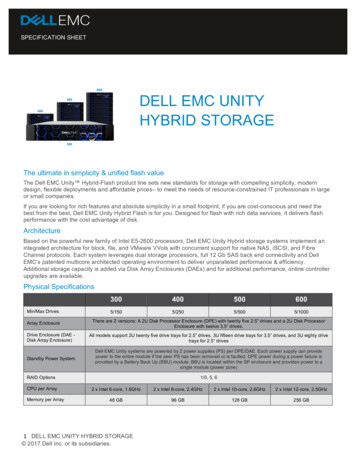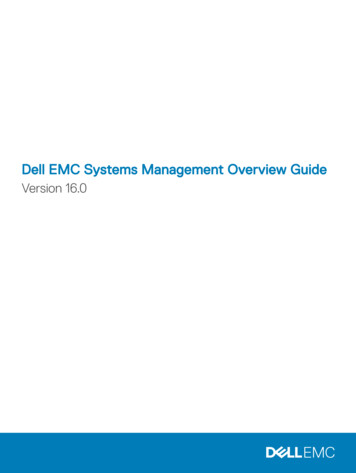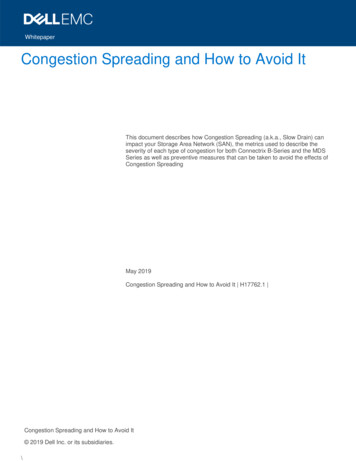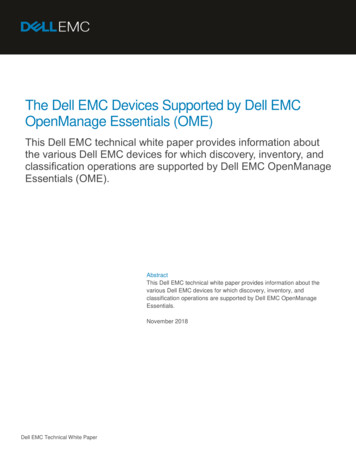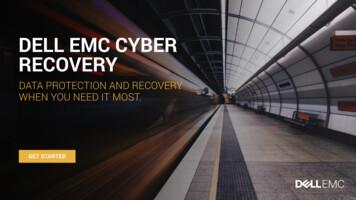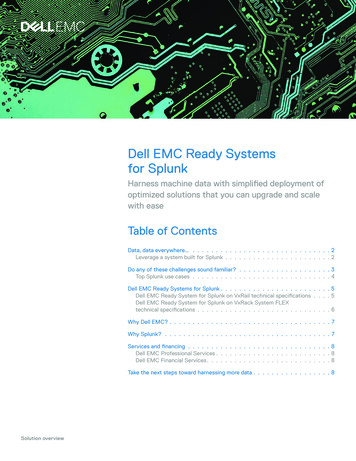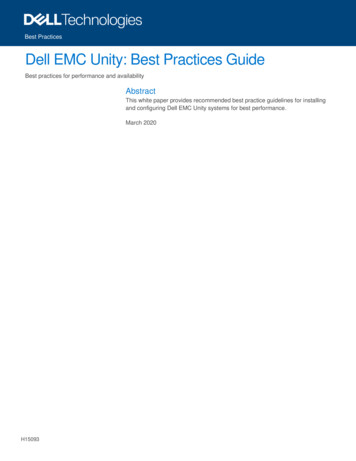
Transcription
Best PracticesDell EMC Unity: Best Practices GuideBest practices for performance and availabilityAbstractThis white paper provides recommended best practice guidelines for installingand configuring Dell EMC Unity systems for best performance.March 2020H15093
RevisionsRevisionsDateDescriptionMay 2016Initial release – Unity OE 4.0December 2016Updated for Unity OE 4.1July 2017Updated for Unity OE 4.2March 2018Updated for Unity OE 4.3August 2018Updated for Unity OE 4.4January 2019Updated for Unity OE 4.5June 2019Updated for Unity OE 5.0August 2019Minor correctionsFebruary 2020Branding update for VMware vSphere Virtual Volumes (vVols)March 2020Minor correctionsAcknowledgmentsThis paper was produced by the following:Author: Stephen WrightThis document may contain certain words that are not consistent with Dell's current language guidelines. Dell plans to update the document oversubsequent future releases to revise these words accordingly.This document may contain language from third party content that is not under Dell's control and is not consistent with Dell's current guidelines for Dell'sown content. When such third party content is updated by the relevant third parties, this document will be revised accordingly.The information in this publication is provided “as is.” Dell Inc. makes no representations or warranties of any kind with respect to the information in thispublication, and specifically disclaims implied warranties of merchantability or fitness for a particular purpose.Use, copying, and distribution of any software described in this publication requires an applicable software license.Copyright 2016-2021 Dell Inc. or its subsidiaries. All Rights Reserved. Dell Technologies, Dell, EMC, Dell EMC and other trademarks are trademarksof Dell Inc. or its subsidiaries. Other trademarks may be trademarks of their respective owners. [3/9/2021] [Best Practices] [H15093.7]2Dell EMC Unity: Best Practices Guide H15093
Table of contentsTable of contentsRevisions.2Acknowledgements .2Table of contents .3Executive summary.51System configuration .61.1Essential guidelines .61.1.1 Maximize Flash capacity .61.1.2 Distribute workloads across all available resources .61.1.3 Simplify the configuration .61.1.4 Design for resilience .61.1.5 Maintain latest released Dell EMC Unity operating environment version .71.2SAS cabling and drive placement.71.3Hot spares .81.4Front-end connectivity .81.4.1 Fibre Channel .91.4.2 iSCSI .91.4.3 NAS .91.5Hardware capability guidelines .101.5.1 CPU utilization .101.5.2 Connectivity options .111.5.3 Drives .1321.6Sizing Dell EMC Unity for performance requirements .141.7Dell EMC UnityVSA .14Storage configuration .152.1General recommendations for storage pools .152.1.1 Storage pool capacity .152.1.2 RAID protection .152.2Traditional pools .152.2.1 RAID protection .162.2.2 All-Flash pool .162.2.3 Hybrid pool.162.2.4 System drives .172.3Dynamic pools .172.3.1 RAID protection .173Dell EMC Unity: Best Practices Guide H15093
Table of contents2.3.2 Spare capacity .182.43Storage object types .18Features .193.1FAST VP .193.2FAST CACHE .193.3Data reduction .193.3.1 Advanced deduplication .203.4Snapshots .203.5Thin clones .213.6Asynchronous replication .213.7Synchronous replication / Metrosync .213.8SAN Copy .223.9NDMP .223.10 Data At Rest Encryption (D@RE) .223.11 Host I/O limits .224Application considerations.234.1Host alignment for block LUNs .234.2VMware ESXi.234.2.1 Multipathing .234.2.2 iSCSI .234.2.3 VMware NFS datastores .234.2.4 vVols .234.3Transactional applications .234.4Sequential applications .235Conclusion .25ATechnical support and resources .26A.14Related resources .26Dell EMC Unity: Best Practices Guide H15093
Executive summaryExecutive summaryThe best practices guide delivers straightforward guidance to customers using Dell EMC Unity storagesystems in a mixed business environment. The focus is on system performance and maximizing the ease ofuse of the automated storage features, giving guidance to achieve optimal performance, while avoiding nonoptimal configurations.These guidelines are intended to cover the majority of use cases. They are strongly recommended by DellTechnologies; however, they are not strictly required. In some cases it is completely acceptable not to adhereto them.Some exception cases are addressed in this guide; however, less commonly encountered edge cases are notcovered by general guidelines, and are instead addressed in use-case-specific white papers.If you have questions about the applicability of these guidelines in your environment, contact your DellTechnologies representative to discuss the appropriateness of the recommendations.This guide occasionally presents example configuration choices in order to demonstrate how a certainrecommendation might be applied. Examples will be presented as follows:EXAMPLE: Here is one possible way to apply the recommendation Examples presented in this way are intended to show one possible configuration option, and do notnecessarily represent a preferred configuration.5Dell EMC Unity: Best Practices Guide H15093
System configuration1System configuration1.1Essential guidelinesDell EMC Unity is a virtually provisioned, Flash optimized storage system designed for ease of use. Thisguide introduces specific configuration recommendations that enable good performance from Dell EMC Unity.At the highest level, good performance design follows a few simple rules. The main principles of designing aDell EMC Unity system for performance are:1.1.1 Maximize Flash capacity Distribute workloads across available storage resources Simplify the configuration Design for resilience Maintain latest released Dell EMC Unity Operating Environment versionMaximize Flash capacityDell EMC Unity utilizes the latest technology in multicore processors, capable of high levels of storageperformance. In order to realize the performance potential, Dell Technologies recommends the use of Flashdrives in all Dell EMC Unity systems. The best way to harness the power of Flash is to ensure as muchdataset as possible resides on Flash drives. Therefore, Dell Technologies recommends provisioning as muchFlash capacity as possible. Use the largest Flash drives appropriate for your solution.1.1.2Distribute workloads across all available resourcesIn order to maximize system performance, eliminate individual bottlenecks by utilizing all hardware resources.Spread Flash drives across back-end buses. Build storage pools with many drives. Balance LUNassignment and NAS Servers across both Storage Processors (SPs). Spread host connections across asmany front-end ports as possible.1.1.3Simplify the configurationDesigning for simplicity also increases the system’s flexibility, and leads to higher, more consistentperformance. Using fewer storage pools means that more drives can be devoted to any single workload inthe pool, possibly improving performance. Standardizing on a single capacity drive per tier, rather thanprovisioning a system with multiple drive sizes for different purposes, can reduce the number of required hotspares (see the Hot Spares section for more details), make it possible to build larger pools, and enablegreater flexibility for future reconfiguration, if needed.When in doubt about the impact of certain configuration options, selecting the recommended default istypically the best choice.1.1.4Design for resilienceHardware can fail, and Dell EMC Unity is architected to continue providing storage services under suchconditions. Understand the hardware limitations of different components of the Dell EMC Unity system inorder to design a solution that continues to provide good performance under failure conditions. (Hardwarecapabilities of different components are provided later in this document.)6Dell EMC Unity: Best Practices Guide H15093
System configuration1.1.5Maintain latest released Dell EMC Unity operating environment versionDell Technologies regularly updates the Dell EMC Unity Operating Environment in order to improveperformance, enhance functionality, and provide new features. Dell Technologies recommends running thelatest version on your Dell EMC Unity system.1.2SAS cabling and drive placementDell EMC Unity systems have 2 on-board 12Gb SAS ports in each of the SPs in the Disk ProcessorEnclosure (DPE), for connecting to Disk Access Enclosures (DAEs). A 4-port 12Gb SAS I/O Module can alsobe provisioned in some Dell EMC Unity systems in order to provide additional back-end buses. In general,the on-board SAS ports provide sufficient IOPS and bandwidth capabilities to support most workloads. TheSAS I/O Module should be considered in systems which will require extremely high bandwidth performance(greater than 10GB/s), or will attach more DAEs or drives that are supported with the on-board buses, or willattach an 80-drive dense enclosure with high-bandwidth option. The SAS I/O Module consumes anexpansion slot that could otherwise be used for front-end connectivity.When cabling DAEs to the DPE, balance them as evenly as possible across all available buses. When onlythe 2 SAS ports on each DPE are available, it is recommended to connect DAEs in the following order: DAE 1 connects to SAS Bus 1 (on-board port 1) DAE 2 connects to SAS Bus 0 (on-board port 0) DAE 3 connects to SAS Bus 1 (on-board port 1)Connect additional DAEs in the same rotation.When provisioning the 4-port SAS I/O Module, it is recommended to connect DAEs in the following order: DAE 1 connects to SAS Bus 1 (on-board port 1) DAE 2 connects to SAS Bus 2 (I/O Module port 0) DAE 3 connects to SAS Bus 4 (I/O Module port 2) DAE 4 connects to SAS Bus 3 (I/O Module port 1) DAE 5 connects to SAS Bus 5 (I/O Module port 3) DAE 6 connects to SAS Bus 0 (on-board port 0)Once all buses have at least 1 connected DAE, connect additional DAEs in the same rotation.80-drive dense enclosures can connect and intermix with other DAEs. When connecting multiple 80-driveenclosures to a system, place them on as many separate buses as possible, before daisy chaining them on asingle bus.80-drive dense enclosures can also be connected with a high bandwidth option that utilizes 2 SAS buses perenclosure, ganging them together for higher performance. This option is only available on Dell EMC Unitysystems that support the SAS I/O Module. Dell Technologies recommends connecting these enclosures withthis high bandwidth option, when possible.7Dell EMC Unity: Best Practices Guide H15093
System configurationFlash drives have the highest performance potential of any drive type. Therefore, Dell Technologiesrecommends spreading Flash drives across all available buses, if possible, to ensure the best IOPS andservice times.1.3Hot sparesNote that dynamic pools do not require dedicated hot spares. See the Dynamic Pools section for additionalconsiderations.When using traditional storage pools, Dell EMC Unity automatically reserves 1 unbound drive out of every 31drives of a given type for use as a hot spare. Note that hot spare drives have no special configuration, theysimply remain unbound. Dell EMC Unity will not allow a traditional storage pool to be created or expandedunless the available number of unbound drives is sufficient to create the requested pool and continue tosatisfy the hot spare policy. Consider spare drive count requirements when designing traditional storage poollayouts.Required hot spare count can be reduced by decreasing the number of individual drive types within thesystem. Table 1 illustrates this point—Hot spare reservation exampleDrives for traditional storage poolsTotal requires spare drivesSystem 19x 600GB SAS 15K3 total:25TB usable9x 1200GB SAS 10K1x 600GB SAS 15K9x 1800GB SAS 10K1x 1200GB SAS 10K1x 1800GB SAS 10KSystem 227x 1200GB SAS 10K25TB usable1 total:1x 1200GB SAS 10KNote that Dell EMC Unity will throttle hot spare rebuild operations to reduce the impact to host I/O. Rebuildswill occur more quickly during periods of low system utilization.1.4Front-end connectivityDell EMC Unity provides multiple options for front-end connectivity, via on-board ports directly on the DPE oroptional mezzanine card, and via optional I/O Modules. This section discusses recommendations for thedifferent types of connectivity.In general front-end ports need to be connected and configured symmetrically across the 2 storageprocessors (SPs), in order to facilitate high availability and continued connectivity in case of SP failure.EXAMPLE: A NAS Server is configured so that NAS clients connect via port 0 of the first I/O Module on SPA;therefore port 0 of the first I/O Module on SPB must be cabled so that it is accessible to the same networks.For best performance, it is recommended to use all front-end ports that are installed in the system, so thatworkload is spread across as many resources as possible.8Dell EMC Unity: Best Practices Guide H15093
System configurationEXAMPLE: If configuring the 4-port Fibre Channel I/O Module, zone different hosts to different ports so thatall 8 ports across the 2 SPs are utilized; don’t simply zone all hosts to the first port of each I/O Module.1.4.1Fibre ChannelWhen configured for Fibre Channel, Dell EMC Unity CNA ports and I/O Module ports can be configured with8Gb or 16Gb SFPs. All Fibre Channel ports can negotiate to lower speeds. 16Gb FC is recommended forthe best performance.Dell Technologies recommends single-initiator zoning when creating zone sets. For high availabilitypurposes, a single host initiator should be zoned to at least 1 port from SPA and 1 port from SPB. For loadbalancing on a single SP, the host initiator can be zoned to 2 ports from SPA and 2 ports from SPB. Whenzoning additional host initiators, zone them to different SP ports when possible, to spread the load across allavailable SP ports.Utilize multi-pathing software on hosts connected via Fibre Channel, such as Dell EMC PowerPath, whichcoordinates with the Dell EMC Unity system to provide path redundancy and load balancing.1.4.2iSCSIDell EMC Unity supports iSCSI connections on multiple 1Gb/s, 10Gb/s, and 25Gb/s (on Dell EMC Unity XT)port options. 10GBase-T ports can auto-negotiate to 1Gb/s speeds. Use the highest speed possible for thebest performance. If possible, configure Jumbo frames (MTU 9000) on all ports in the end-to-end network, inorder to provide the best performance.To achieve optimal iSCSI performance, use separate networks and VLANs to separate iSCSI traffic fromnormal network traffic. Configure standard 802.3x Flow Control (Pause or Link Pause) on all iSCSI Initiatorand Target ports that are connected to the dedicated iSCSI VLAN.Dell EMC Unity supports 10GbE and 1GBase-T ports that provide iSCSI offload. Specifically, the CNA ports(when configured as 10GbE or 1GBase-T) and the 2-port 10GbE I/O Module ports provide iSCSI offload.Using these modules with iSCSI can reduce the protocol load on SP CPUs by 10-20%, so that those cyclescan be used for other services. Note that iSCSI offload is not available for Dell EMC Unity XT models.Utilize multi-pathing software on hosts connected via iSCSI, such as Dell EMC PowerPath, which coordinateswith the Dell EMC Unity system to provide path redundancy and load balancing.1.4.3NASDell EMC Unity supports NAS (NFS, FTP, and/or SMB) connections on multiple 1Gb/s, 10Gb/s, and 25Gb/s(on Dell EMC Unity XT) port options. 10GBase-T ports can auto-negotiate to 1Gb/s speeds. Use the highestspeed possible for the best performance. If possible, configure Jumbo frames (MTU 9000) on all ports in theend-to-end network, in order to provide the best performance.Dell Technologies recommends configuring standard 802.3x Flow Control (Pause or Link Pause) on allstorage ports, switch ports, and client ports that are used for NAS connectivity.Dell EMC Unity provides network redundancy for NAS via Link Aggregation Control Protocol (LACP) and FailSafe Networking (FSN). Combine FSN and LACP with redundant switches to provide the highest networkavailability. In addition to redundancy, LACP can also improve performance with multiple 1GBase-Tconnections, by aggregating bandwidth. LACP can be configured across any Ethernet ports that have thesame speed, duplex, and MTU. (Note that LACP cannot be enabled on ports that are also used for iSCSIconnections.)9Dell EMC Unity: Best Practices Guide H15093
System configurationWhile LACP creates a link aggregation with multiple active links, FSN provides redundancy by configuring aprimary link and a standby link. The standby link is inactive unless the entire primary link fails. If FSN isconfigured with links of different performance capability (such as a link aggregation of 10Gb/s ports, and astand-alone 1Gb/s port), it is recommended to configure the highest performing link as the primary.NAS Servers are assigned to a single SP, and all file systems serviced by that NAS Server will have I/Oprocessed by the SP on which the NAS Server is resident. For load-balancing, it is recommended to createat least 2 NAS Servers per Dell EMC Unity system, 1 on SPA, and 1 on SPB. Assign file systems to eachNAS Server such that front-end workload is roughly the same for each SP.1.5Hardware capability guidelinesThe following sections provide information on expected maximum performance from different hardwarecomponents of Dell EMC Unity. Dell Technologies does not recommend continuously operating a hardwareresource near its maximum potential. When utilization is below the maximum level, average response timeswill be better, the system will be able to handle activity bursts without becoming overloaded, and performancemay still be maintained during hardware failure scenarios.For some of the following hardware sections, both IOPS and bandwidth (MB/s) capabilities are shown. Adifferent type of workload is assumed when determining IOPS capabilities versus when determiningbandwidth capabilities: IOPS workloads assume random small-block access. The following numbers are specifically modeled ona workload with a mix of I/O sizes less than 64KB, containing both read and write operations, and accessingrandomly selected blocks within the datasets. Bandwidth workloads assume sequential large-block access. The following numbers are specificallymodeled on a workload with a mix of I/O sizes greater than 64KB, containing both read and write operations,and accessing contiguous blocks of data with minimal seek.This data is offered as a guideline for what most customers can expect for maximum performance capabilitiesfrom certain hardware. Note that individual components in your specific system may be able to provide higheror lower numbers, based on differences in workload characteristics and environment.Most hardware components in the Dell EMC Unity system can be monitored in Unisphere, via the SystemPerformance page.1.5.1CPU utilizationDell EMC Unity is designed to achieve the maximum performance possible from today’s multi-coreprocessors. The Dell EMC Unity architecture results in non-linear CPU utilization increases as the workloadscales.EXAMPLE: A Dell EMC Unity system reporting 50% CPU might still be capable of providing more than 3times the current workload.It is recommended to balance workload across the 2 SPs, such that CPU utilization is roughly equivalent oneach SP.Table 2 provides recommended operating ranges, in terms of sustained CPU utilization. Brief spikes of highutilization are normal and expected on any system. The following values refer to average sustained levelsover long periods of time. This table also provides the expected system behavior in the case that a single SP10Dell EMC Unity: Best Practices Guide H15093
System configurationwould need to service the entire workload (such as coordinated reboots during upgrades, or if a single SPfails, etc.).Recommended sustained CPU utilizationReported CPUAnalysisutilizationBelow 0%(Highutilization)Expected singleSP behaviorEnable datareduction?Enable snapshotsand/or replicationSystem is capable ofaccepting additionalfeatures andworkloads.A single SP shouldbe able to servicethe entire workloadwhile maintainingexisting IOPS andresponse time.Data Reduction canbe enabled on thestorage objects inthis system.Snapshots andReplication can beenabled on the storageobjects in this system.System is operatingnormally, and may becapable of acceptingadditional featuresand workloads.A single SP shouldbe able to servicethe entire workloadwhile maintainingexisting IOPS andresponse time.Choose the bestcandidate storageobjects, and enableData Reduction ononly a few at a time(see the DataReduction section)Enable Snapshots orReplication on only afew storage objects ata time.System is nearingsaturation; carefullyconsider whetheradditional featuresand workload shouldbe added to thissystem.A single SP shouldbe able to maintainthe existing IOPSload; however,increases inresponse time maybe experienced.Data Reductionshould not beenabled on anyadditional storageobjects in thissystem.Choose the bestcandidate storageobjects, and enableSnapshots orReplication on only afew at a time (see theSnapshots section).A single SP willlikely not be able tomaintain the existingIOPS load.Do not enable DataReduction on anyadditional storageobjects in thissystem.Do not enableSnapshots orReplication on anyadditional storageobjects in this system.System is saturated;additional workloadshould not be applied(Extremelyhigh utilization) to the system;consider movingsome wo
the 2 SAS ports on each DPE are available, it is recommended to connect DAEs in the following order: DAE 1 connects to SAS Bus 1 (on-board port 1) DAE 2 connects to SAS Bus 0 (on-board port 0) DAE 3 connects to SAS Bus 1 (on-board port 1) Connect additional DAEs in the same rotation.




